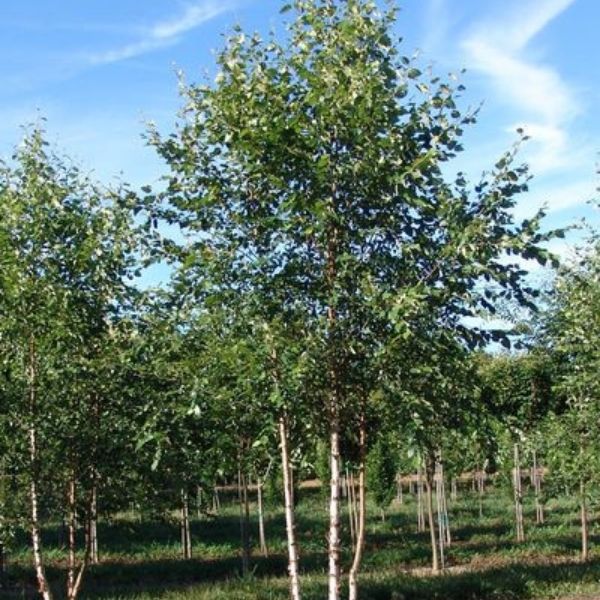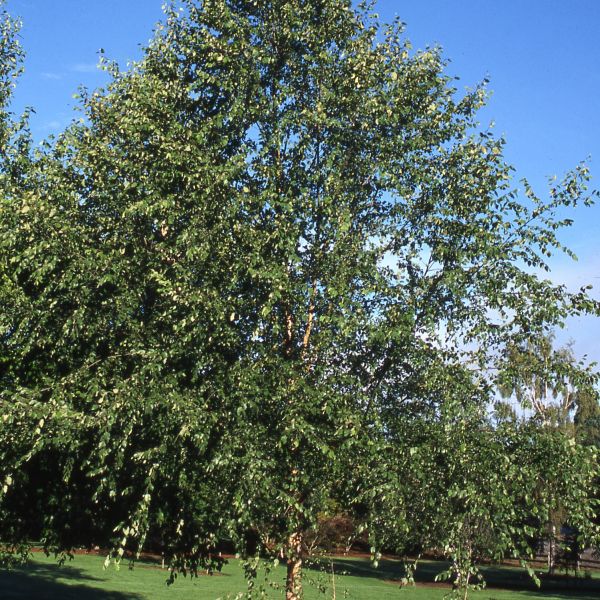

Dura Heat River Birch
Betula nigra 'BNMTF'
89 reviews
Dura Heat River Birch
Betula nigra 'BNMTF'
89 reviews
- 3.5 Gallon 4-5 Feet Multi Stem
- 3.5 Gallon 4-5 Feet Single Stem
We are sorry, product is currently out of stock due to seasonal availability. Please check the "Related plants available in your area" section below
Not just beautiful - intentionally selected by ShrubHub's 3D landscape design team to fit real-world spaces and maximize yard potential.
Why Dura Heat River Birch?
The Dura Heat River Birch (Betula nigra 'BNMTF') is a great choice for homeowners who want a beautiful, low-maintenance tree that can withstand harsh weather conditions. This tree is heat and drought tolerant, making it ideal for landscapes in hot and arid regions. Its unique exfoliating bark and dense canopy also provide year-round interest and shade. Additionally, the Dura Heat River Birch is resistant to the bronze birch borer, which is a common pest that can kill other birch trees.
Sunlight
Dura Heat River Birch (Betula nigra 'Dura Heat') requires full sun to partial shade, preferably receiving at least six hours of direct sunlight per day.
Watering
The Dura Heat River Birch has a medium to high watering requirement. It prefers consistently moist soil and benefits from regular deep watering during dry periods to prevent the soil from drying out completely.
Fertilizing
The fertilizer requirement for Dura Heat River Birch is a balanced slow-release fertilizer with a nitrogen-phosphorus-potassium (NPK) ratio of 10-10-10 or 14-14-14. Application should be done in early spring and late fall to promote healthy growth.
Looking For Heat & Disease Resistant Shade Trees? Try Out Dura Heat River Birch Trees
The Dura Heat River Birch is a medium-sized deciduous shade tree that typically grows up to 40 feet tall and 25 feet wide. Its attractive bark is a beautiful creamy white color that peels away in thin sheets to reveal a reddish-brown inner bark. The leaves are dark green and have a unique triangular shape that adds texture and interest to any landscape.
What sets the Dura Heat River Birch apart from other river birches is its exceptional heat tolerance. This tree can thrive in hot, dry climates where other river birches may struggle. In addition, it has a fast growth rate, so you can enjoy its beauty and shade in no time.
Owning this beautiful tree comes with many benefits. Its heat tolerance & disease resistance means that it requires less watering and maintenance than other trees, making it a low-maintenance addition to your yard. Its fast growth rate also means that it can quickly provide shade and privacy to your property. Plus, its unique triangular leaves and creamy white bark add visual interest and beauty to any landscape.
The Dura Heat Birch is a versatile tree that can be used in many landscaping and gardening applications. Plant it as a specimen tree in your front yard to add curb appeal and value to your property. Use it to create a natural privacy screen or windbreak. Or plant it in a cluster to create a beautiful focal point in your backyard.
Don't miss out on the opportunity to own a Dura Heat River Birch! Purchase this exceptional tree and enjoy its many benefits for years to come.
Plant Information:
| Botanical Name: | Betula nigra 'BNMTF' |
| USDA Zones: | 4 - 9 |
| Water: | Moderate |
| Exposure: | Full Sun |
| Soil Needs: | Widely Adaptable |
| Mature Height: | 30 - 40 feet |
| Mature Spread: | 20 - 30 feet |







Pollination Info
Pollination Information for Dura Heat River Birch
The Dura Heat River Birch (Betula nigra 'BNMTF') is a deciduous tree that is commonly grown for its heat tolerance and beautiful bark. Although it does produce small flowers in the spring, they are not significant for pollinators.
The tree is wind-pollinated, which means pollination occurs when the male flowers release pollen and it is carried by the wind to the female flowers. As such, there is no need for bees or other pollinators to visit the tree for fruit production.
The Dura Heat River Birch is not commonly grown for fruit production, but occasionally it may produce small nutlets that are eaten by wildlife. However, these are not a significant source of food for most animals.
Overall, the Dura Heat River Birch does not rely on pollinators for reproduction or fruit production, making it a low-maintenance tree with minimal impact on local ecosystems.
FAQ
Dura Heat River Birch (Betula nigra 'BNMTF') FAQ:
What is a Dura Heat River Birch?
The Dura Heat River Birch (Betula nigra 'BNMTF') is a deciduous tree that is known for its beautiful bark and tolerance to heat and drought.
How tall does a Dura Heat River Birch grow?
The Dura Heat River Birch typically grows to be about 40-50 feet tall with a spread of 25-35 feet.
What is the ideal growing zone for a Dura Heat River Birch?
The Dura Heat River Birch thrives in USDA Hardiness Zones 4-9.
What soil type should be used when planting a Dura Heat River Birch?
The Dura Heat River Birch prefers moist, well-drained soils that are on the acidic side. Avoid planting in heavy, clay soils.
How much sunlight does a Dura Heat River Birch require?
The Dura Heat River Birch prefers full sun to partial shade.
How much water does a Dura Heat River Birch need?
The Dura Heat River Birch requires regular watering, especially during periods of drought. However, be sure to avoid over-watering as this can lead to root rot.
Should the branches of a Dura Heat River Birch be pruned?
The Dura Heat River Birch can benefit from annual pruning to remove any dead, diseased, or damaged branches. It is best to prune in late winter or early spring before new growth begins.
Does a Dura Heat River Birch have any pest or disease issues?
The Dura Heat River Birch is susceptible to bronze birch borer and leaf spot diseases. Proper care, including regular watering and pruning, can help prevent these issues.
Planting & Care
Planting:
Dura Heat River Birch prefers full sun to partial shade and moist, well-drained soil with a slightly acidic pH. Choose a planting location with good drainage, as the tree does not tolerate waterlogged soil.
1. Dig a hole that is two to three times wider than the tree's root ball, and the same depth as the root ball.
2. Loosen the soil around the sides and bottom of the hole with a garden fork or shovel.
3. Gently remove the tree from its container, and loosen any tangled or circling roots.
4. Place the tree in the center of the hole, making sure the top of the root ball is level with the surrounding soil.
5. Backfill the hole with the soil that was removed, and firm the soil around the base of the tree with your hands or foot.
6. Water the tree thoroughly, saturating the soil around the roots.
7. Mulch around the tree with a 2 to 3 inch layer of organic mulch, keeping the mulch away from the base of the trunk.
Care:
1. Water the tree deeply once a week, or more frequently during hot, dry weather. The soil should be moist but not waterlogged.
2. Fertilize once a year in the spring with a slow-release fertilizer that is high in nitrogen.
3. Prune in late winter or early spring before the tree begins to leaf out. Remove dead, damaged, or diseased branches, as well as any crossed or rubbing branches.
4. Watch for signs of pests or diseases, including bronze birch borer, leaf spot, and canker. If necessary, treat with an appropriate insecticide or fungicide.
5. Monitor the tree for suckers or root sprouts, which should be removed promptly to prevent them from becoming new trees.
Check Out These Verified Customer Reviews:
Customer Reviews
4.7 out of 5 based on 89 reviews
Thank you! Your review has been submitted.
Excellent customer service, very responsive
Easy to navigate website, good descriptions
Smooth shipment process, no issues
Item has been added to your cart.


